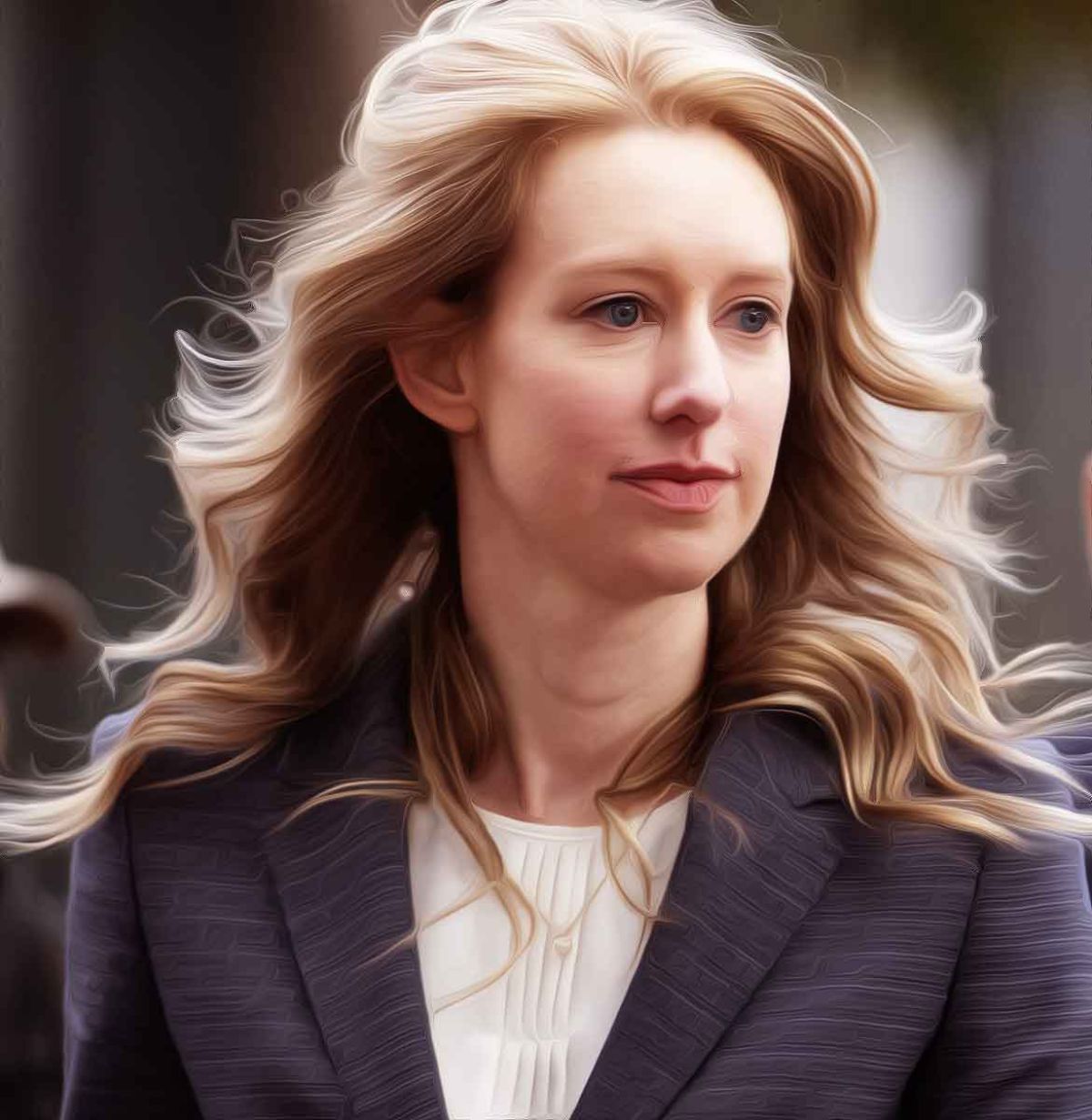MORE COVERAGE
Twitter Coverage
Satyaagrah
Written on
Satyaagrah
Written on
Satyaagrah
Written on
Satyaagrah
Written on
Satyaagrah
Written on
JOIN SATYAAGRAH SOCIAL MEDIA
"Supernatural evil is not necessary. Men alone are quite capable of every wickedness": Silicon Valley fraud of "fake it till you make it" - Elizabeth Holmes, the "next Steve Jobs" sentenced to over 11 years in prison for a multi-million-dollar fraud

She came, she saw the meteoric rise of her company but then she fell.
|
That’s Elizabeth Holmes for you. The Chief Executive Officer (CEO) of Theranos Elizabeth Holmes has been sentenced to over 11 years in prison for defrauding her investors.
Several media reports suggest that Holmes, 38, had falsely claimed that her ‘revolutionary’ blood-testing technology could diagnose various diseases with the help of just a few drops of blood.
Once touted as the “next Steve Jobs”, things were not always this bad for this Silicon Valley Star.
Let’s take a closer look at the rise and fall of Elizabeth Holmes.
|
Who is Elizabeth Holmes?
Born on 3 February 1984, Elizabeth had shown signs of thinking outside the box. A native of Washington DC, her mother Noel used to be a Congressional committee staffer while her father, Christian Holmes, worked for Enron – an American energy and services company. He later switched to work for government agencies like United States Agency for International Development (USAID).
At the age of nine, Elizabeth wrote a letter to her father penning her dreams and aspirations. In the letter, she said, “What I really want out of life is to discover something new, something that mankind didn’t know was possible to do,” according to a report by CBS News.
The entrepreneur inside her started to play out at a very young age when as a teenager she started her own business where she sold C++ compilers – a computer code – to Chinese schools.
Her inspiration for getting into the field of medicine came from her great-great-grandfather who was a surgeon. Along with this, her own fear of needles and injections played out well for her as it gave her the idea of starting her company Theranos.
A brilliant student, Holmes went on to study chemical engineering in Stanford University, where she became a “president’s scholar”, an honour which offered $3,000 stipend for research projects.
According to a report by Fortune, in 2003, Holmes (then a sophomore at Stanford) approached her professor Channing Robertson and pitched the idea of starting a company. Impressed by her proposition and keeping in mind her experience of working in a lab at the Genome Institute in Singapore, Robertson said, “I knew she was different. The novelty of how she would view a complex technical problem–it was unique in my experience.”
She soon thought of the idea of creating a wearable patch that would not only administer a drug but would also monitor variables in the patient’s blood to see if the therapy was registering the desired results, without the use of any needle.
When asked why she came up with such an innovation, Holmes said, “Because systems like this could completely revolutionize how effective health care is delivered. And this is what I want to do. I don’t want to make an incremental change in some technology in my life. I want to create a whole new technology, and one that is aimed at helping humanity at all levels regardless of geography or ethnicity or age or gender.”
However, not everyone was on board with Elizabeth’s idea. Sceptics like Phyllis Gardner, an expert in clinical pharmacology at Stanford recalled telling Holmes that her idea “wouldn’t work”.
He told BBC, “She just stared through me. And she just seemed absolutely confident of her own brilliance. She wasn’t interested in my expertise and it was upsetting.”
Nothing stopped Holmes. At the age of 19, she dropped out of Stanford and launched a better version of Theranos in 2003 which, she claimed, had the potential to revolutionise the way of testing blood from a simple finger prick.
|
The meteoric rise of Theranos
The seed idea of Theranos, the ‘Edison’ testing kit brought in many investors to give the push the company needed.
Edison was a machine that could test a variety of diseases by using only a few drops of blood from a person’s finger. It promised to transform blood testing methods around the world.
Apart from this, Theranos also planned to charge half the price of testing services like Medicare and Medicaid in the US, which would have potentially saved the government over $200 billion over the next decade.
It was also hoped that Edison would democratise the testing process, allowing anyone to get a test done at a pharmacy and have it analysed in a matter of a few hours.
Her idea caused a lot of stir and she was able to convince a number of high-profile investors within the next couple of years.
According to a report by Reuters, in just a year, the company raised more than $6 million in funding and reached a valuation of $30 million. By 2009, Ramesh “Sunny” Balwani, who met Holmes in 2002 on a trip to Beijing, joined Theranos as the Chief Operating Officer.
The very next year, the company raised another $45 million in funding, shooting its valuation to $1 billion. In 2011, two former US state secretaries, George Shultz and Henry Kissinger, and media tycoon Rupert Murdoch among others became backed Holmes’ business.
In September 2013, Holmes revealed her long-term partnership with Walgreens – a pharmacy store chain. According to CNN, the first Theranos Wellness Centre was opened in Walgreens in Palo Alto where consumers could access Theranos’ blood test.
Forbes declared Elizabeth Holmes as one of the richest women in America in 2014.
In 2015, the company won US Food and Drug Administration’s approval for a test to detect herpes simplex 1 virus.
|
The fall
The company’s fall was as sharp as its rise.
The secrets began to unravel when a 2015 Wall Street Journal investigation exposed that Theranos had only performed roughly a dozen of the hundreds of tests it offered using its proprietary blood testing device which also put a question mark on its accuracy. It was revealed that the company was relying on third-party manufactured devices from traditional blood testing companies.
Angry investors revoked their partnerships with Theranos while a number of lawsuits were filed against it. In 2016, the US Centres for Medicare and Medicaid Services (CMS) presented a report that said that one of the company’s facilities presented “jeopardy to patient health and safety”. Soon, US regulators banned Holmes from carrying out blood-testing services for two years.
By June, Walgreens, one of the company’s biggest partners, ended terms with Theranos followed by a lawsuit by Partner Fund Management, which had invested heftily, over securities fraud.
In March 2018, the US Securities and Exchange Commission charged Elizabeth Holmes and Ramesh Balwani with securities fraud and Holmes was stripped off of her stake and control of the company. Both plead not guilty.
Within six months, Theranos announced that it will dissolve.
In August 2021, according to a report by Al Jazeera, a court revealed Holmes’ planned to argue that she was under the control of Balwani, who she claims was abusive, at the time of the charged crimes.
|
The conviction
“She knew that they were investing in Theranos based on a false premise. She was aware of the mismatch between what she was presenting to investors and reality,” said prosecutor John Bostic on Friday (18 November) during the trial, as per a report by NPR.
In January 2022, Holmes was convicted of defrauding three other investors. She was, however, acquitted on three counts of defrauding patients who had paid for Theranos’ tests.
The sentence imposed on her on Friday by US District Judge Edward Davila was shorter than the 15-year penalty requested by federal prosecutors. It was, however, far tougher than the leniency her legal team had requested for the mother of a one-year-old son with another child on the way.
firstpost.com Support Us
Support Us
Satyagraha was born from the heart of our land, with an undying aim to unveil the true essence of Bharat. It seeks to illuminate the hidden tales of our valiant freedom fighters and the rich chronicles that haven't yet sung their complete melody in the mainstream.
While platforms like NDTV and 'The Wire' effortlessly garner funds under the banner of safeguarding democracy, we at Satyagraha walk a different path. Our strength and resonance come from you. In this journey to weave a stronger Bharat, every little contribution amplifies our voice. Let's come together, contribute as you can, and champion the true spirit of our nation.
 |  |  |
| ICICI Bank of Satyaagrah | Razorpay Bank of Satyaagrah | PayPal Bank of Satyaagrah - For International Payments |
If all above doesn't work, then try the LINK below:
Please share the article on other platforms
DISCLAIMER: The author is solely responsible for the views expressed in this article. The author carries the responsibility for citing and/or licensing of images utilized within the text. The website also frequently uses non-commercial images for representational purposes only in line with the article. We are not responsible for the authenticity of such images. If some images have a copyright issue, we request the person/entity to contact us at satyaagrahindia@gmail.com and we will take the necessary actions to resolve the issue.
Related Articles
- "In the shadow of trust, lies betrayal's grip": In a chilling exploitation in Bengaluru, a retired 60-year-old man was ensnared in a honeytrap, losing a staggering Rs 82 lakh, police arrested 3, revealing a darker underbelly of blackmail in the city
- "Whoever profits by the crime is guilty of it": Philippines court issues international arrest warrant for Bill Gates in connection to Covid19 vaccine rollout, excess deaths & injuries reported after vaccine drive, Gates Foundation prevents media reporting
- "Heed the whispers; they might just save you": Behind the shadows of international intrigue, George Soros's alleged Hindenburg 2.0 agenda looms large, as India's 2024 Elections approach, what mysteries will unfold in the realm of finance and politics?
- More than Rs 400 crore of assets attached by ED belonging to 'Lottery King' Santiago Martin and Saravana Stores Gold Palace over money laundering charges, assets consist of movable and immovable properties in form of bank accounts and land in Tamil Nadu
- UP Police deployed Bulldozer forced kingpin of a car theft syndicate Nasiruddin to spill out the secrets of his illicit business: Accused revealed all his accomplices Shahid, Riajul, Imran, Furkan, and Armaan
- "Fraud and falsehood only dread examination. Truth invites it": DMK Minister Senthil Balaji rolls around & cries uncontrollably of chest pain when taken into custody on corruption charges by ED, he is 2nd most powerful man & money bank of the ruling party
- Natwar Singh, an ex-foreign minister, and the Congress Party through a series of illegal oil transactions under Saddam Hussein’s regime’s oil-for-food program were involved in the Iraqi oil scam: Detail in the Volcker Committee Report
- "A legacy tarnished in the blink of an eye": Mumbai's legendary Bademiya eatery slapped with a stop-work notice amidst alarming hygiene concerns, following a shocking discovery of rats and cockroaches infesting the premises, leaving patrons outraged
- Delhi HC Justice says, "not that the financial frauds run into thousands of crores, they are just 10-12 crores and she has old parents here": Donation fraud accused Rana Ayyub allowed by HC to travel abroad
- "Rather fail with honor than succeed by fraud": ED hits Byju's with a staggering Rs. 9,000 crore notice for FEMA violations, as CEO Raveendran avoids summons, deepening the crisis in the edtech behemoth amid financial and compliance turmoil
- From juice stalls to orchestrating a billion-rupee scam, Saurabh Chandrakar & Ravi Uppal now revel in infamy, Stars like Tiger Shroff & Sunny Leone highlighted their lavish UAE wedding, exposing a grim nexus of fame and dark money in the Mahadev App saga
- Prima facie evidence found that Nawab Malik conspired with D company members Hasina Parkar, Salim Patel, and Sardar Khan to grab property, directly and deliberately involved in money laundering’: Says Mumbai court
- Kerala Gold smuggling case: Co-accused PS Sarith abducted by few unknown persons from Swapna Suresh's home on Wednesday morning just minutes after explosive revelations in press conference
- "Let the punishment be equal with the offence": Arrogant Monk Amogh Lila Das banned by ISKCON due to his controversial comments on Swami Vivekananda and Ramakrishna Paramhansa, to remain secluded from public life on Govardhan hills for one month
- "चकुबाज़": 10 RSS workers attacked with knives during a Sharad Purnima event at Mahadev Temple in Jaipur, accused Naseeb Chaudhary and his son arrested, six victims hospitalized at Sawai Man Singh, Rajasthan Minister Rathore promising strict action

























